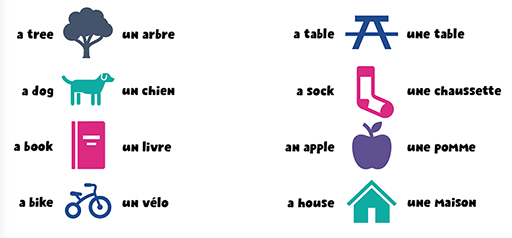3 Nouns and articles in French: introducing gender
So, as was just discussed, a noun is a naming word. When learning French, this is a well-established place to start: learning lists of names for things. Usually these are tangible things: dog, breakfast, hotel, swimming pool, son, daughter. If you have a good memory for these things, you can often get by in a French-speaking country, buying tickets or booking accommodation relatively successfully. Once you start to go beyond the naming of everyday things to, for example, the discussion of your own passions (white-water rafting, volunteering, wine tasting?) and achievements (black belt in judo, spiritual enlightenment?) you will see that nouns become far more exciting to learn.
If you want to practise learning some French vocabulary, why not start by taking some time to research the French for the key nouns you would use to describe your own life, like your family, your home, your hobbies or interests? If you do look up some nouns in a bilingual dictionary (whether that’s a physical book or online), you will notice that the French translations are followed by ‘m.’ or ‘f.’. You will now find out what this means and why it’s provided.
Activity 3 Comparing French and English
Look at the word list below. What do you notice when you compare the French and English?
Discussion
What is interesting to notice from the list is that there are two words in French which are equivalent to the English ‘a’: these are un and une.
The word list in Activity 3 was a list of nouns, but each noun was preceded by ‘a’ in English, and by un or une in French. These are articles, or more precisely ‘indefinite articles’. So why does French have two of them when English only has one?
This is because in the French language, all nouns are categorised as masculine or feminine. This is termed as ‘gender’. As a result, French grammar has a different article for each: un for masculine words, and une for feminine words. There are also masculine and feminine versions of the ‘definite article’ (equivalent to ‘the’ in English): le is masculine (le livre = the book), and la is feminine (la maison = the house). Note that if a noun starts with a vowel (a, e, i, o, u) then both le and la are replaced by l’ (un arbre > l’arbre: the tree; une école > l’école: the school).
Gender is not unique to the French language: Spanish, Italian and German, for example, also categorise nouns according to gender. The grammatical notion of gender exists in English too, but it’s limited to differentiating between male and female individuals and animals. For example, English has the masculine pronoun ‘he’, and the feminine pronoun ‘she’ (among others like ‘they’). Objects and abstract concepts are normally referred to as ‘it’, which is neither masculine or feminine.
What is different in French, and other languages, is that the notion of gender applies to all nouns. For example, the list in Activity 3 shows you that the French nouns for tree, dog, book and bike are masculine, whereas the French nouns for table, sock, apple and house are feminine. This does not mean that each naming word has a particular ‘masculine’ or ‘feminine’ quality, so it’s important as you learn French not to look for that kind of rationale. For example, the word for a man’s shirt in French is feminine (une chemise), but for a woman’s blouse it’s masculine (un chemisier).
This shows how the grammatical notion of gender in French is abstract and arbitrary. As a learner of French, this means that whenever you learn a new noun, you will also have to learn its gender, by learning the article that goes with it. In a dictionary, the gender of French nouns is usually indicated by a small m. or f., for masculine or feminine.

